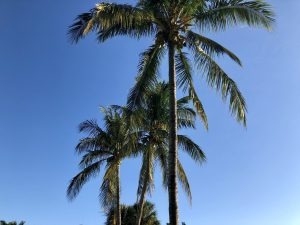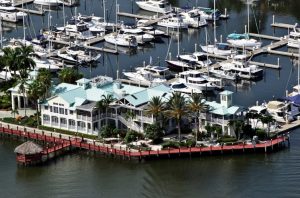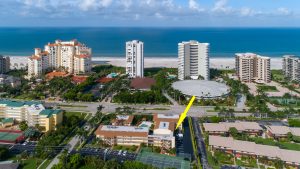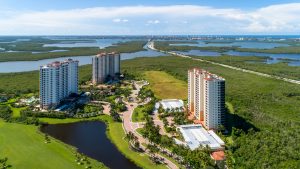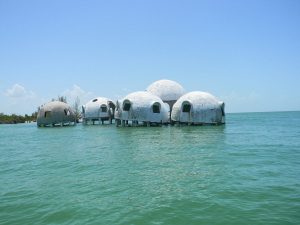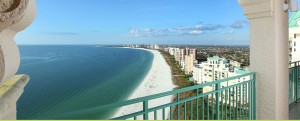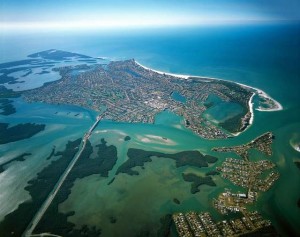Coconut Palm Tree: The coconut palm tree is what many people envision when they think of the quintessential tropical palm. It can grow up to 98 feet tall and has long, wispy leaves that grow in dense bunches, providing ample shade. A note with coconut palm tree care—be sure to properly prune and cut back seeds twice annually, or remove small coconuts to prevent them from falling and potentially causing injury.
African Oil Palm: This palm tree is known for the edible oil its fruit produces, and it’s a great choice in a full-sun South Florida landscape when owners desire more shade. That’s because of its deep-green feathery leaves that appear to spew from the trunk top. (There is no crown shaft.) Its leaves can grow up to 15 feet long. Also, this palm is a medium to fast grower, so you’ll achieve shade more quickly than with other palm tree varieties.
Chinese Fan Palm: The drooping, fan-shaped leaves of the Chinese Fan Palm appear to weep, offering shade. This lower-growing palm tree matures at about 25 feet in height. The interesting fan shape of this palm tree adds texture to the landscape.
Palm trees that thrive in the jungle’s under story are the varieties you’ll select for shaded areas of your South Florida landscape. These palms naturally thrive with low sunlight. Many shade palm trees perform well indoors, as well. Here are a few varieties you might select for your property, and the Walter Team will help you find the perfect property.
Rhapis (Lady Palm): The layered Lady Palm grows multiple, thin trunks and fills in with clusters of green fronds. This palm clusters and grows slowly. Not only does it provide privacy screening because of its lush, full display of foliage, it grows strong in full shade.
Red Sealing Wax Palm: The Red Sealing Wax Palm gets its name from the vibrant crown shaft that is the same color as the wax used to seal documents. You’ll also hear this tree referred to ask Lipstick Palm. The red color extends down from the crown at least 3 feet, and it also radiates into the palm shafts. (The remainder of the trunk is green.) Its feather-like palms are emerald on top and lighter green underneath. Red Sealing Wax Palms require lots of water, and they thrive in boggy spots of your South Florida such as in or near water features.
Chamaedorea Palms: Palm trees in the Chamaedorea family are known for their ability to thrive in shaded landscapes and indoors. Within this family are Bamboo Palms, which are great container growers. Leaves range from fine and feathery to thicker, depending on the type of Bamboo Palm. It thrives in well-drained soil, and can withstand temperatures just below freezing. (We rarely see nights like this in South Florida, but it goes to show how hardy Bamboo Palms are.)
When selecting palm trees for the poolside, consider the palm’s sunlight requirements and how much coverage you hope to achieve from the plant. Are you looking for a palm tree that will provide some privacy screening and shade from the sun? Or, do you want a more formal, slender palm that will add structure to the pool area? Palms range in height, growing habit and leaf texture. So, there is a palm tree to suit most any style and a full range of growing conditions. Here are a few poolside palm trees we like. The Walter Team can show you the best poolside areas to buy, and the perfect spot to be enhanced by Florida’s beautiful palm trees.
Buccaneer Palm: This is a great all-around palm tree for South Florida landscapes, including by the poolside. It’s incredibly versatile and thrives in a range of environmental conditions. The native palm is a slow grower and thrives in full sun. Buccaneer Palms require virtually no water, so it is drought-tolerant and low maintenance. Its palms range in color from green to blue-green and silver. They generally reach 10 to 15 feet in height, and their flat, fan-shaped leaves provide coverage from the Florida heat.
Montgomery Palm: This tropical palm tree grows up to 35 feet tall and they are often planted in symmetrical rows to create a border in the Florida landscape. Its palm fronds are stiff, feathered and emerald green. It features a long crown shaft, and the overall stature of the palm tree creates a formal feel.
Palm trees can replace hedges and shrubs in the landscape when you select lower-growing varieties. There are hundreds of small palm trees available, and several are particularly successful in South Florida. The Walter Team can show you houses that will be perfect to be enhanced by beautiful palm trees.
Robellini Palm: The Robellini Palm grows 6 to 12 feet tall, making it a perfect-sized plant for landscape bed areas and smaller spaces where a 30- to 50-foot tall palm tree would look out of place. It features a bushy palm crown with fronds that can create an overall span of 10 feet. So while the Robellini might be a small palm tree, it certainly makes an impact. We love the interesting, spiny branches for their texture. However, you might want to avoid placing a Robellini close to pedestrian walkways where someone might accidentally rub up against its trunk.
European Fan Palm: The trunk of the European Fan Palm is somewhat furry, and its pomade-style leaves are fan-like (unlike Robelinni with its feathery leaves). These leaves are green to silver, offering an appealing hue change. The evolving show of color and appealing textures this palm tree bring to the landscape make it a versatile, eye-catching choice if you’re seeking a small palm.
Put The Right Palm In The Right Place On Your South Florida Landscape
As with selecting any type of plant, it’s all about choosing the best variety for your climate and specific location. (Keep in mind, you’ve got micro-climates on your Florida property areas of shade, full-sun, wind exposure, damper soils and dry spots.) That’s why it’s wise to consult with an experienced landscape professional that can guide you toward the best palm tree for your South Florida landscape.
CALL THE WALTER TEAM TODAY FOR THE PERFECT PROPERTY TO SHOWCASE YOUR FAVORITE PALM TREES. PH# 239-821-0994

 Back Home
Back Home
